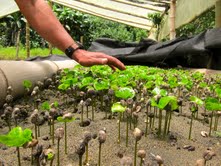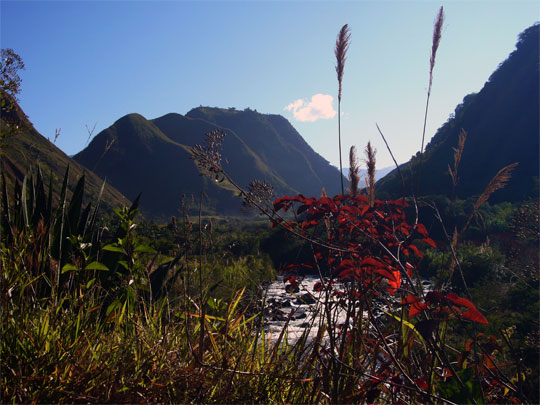A Peaceful Backlash: One Ecuadorian Community’s Response to Neoliberalism

The wave of neoliberal reforms sweeping Latin America in the 1980s sparked a series of brutal fights in rural Ecuador to preserve the natural resources threatened by transnational mining companies. The people of Íntag, a region in Ecuador’s extremely bio-diverse Cloud Forest on the western slope of the Andes, have waged a 20-year battle against the ecologically and socially destructive forces of neoliberalism. Rather than resorting to violence, the people use ecological and community tourism projects, organic fair-trade coffee cultivation, and the production of artisanal crafts as their arsenal in this struggle. Such small-scale, community-oriented enterprises constitute a form of alternative development that provides social empowerment, achieved in part by increasing women’s economic autonomy. Moreover, these efforts create income-generating opportunities for the impoverished region, enabling the community to exist independently of the neoliberal economic initiatives threatening to overwhelm the cultural and biological landscapes of the region.
Impacts of Neoliberalism in Ecuador
In 1967, geologists discovered oil beneath Ecuador’s rich and varied landscape. By the early 70s, oil comprised the majority of Ecuador’s export revenues.(1) The authoritarian regimes of José María Velasco and General Guillermo Rodriguez Lara used these oil revenues to promote nationalism by subsidizing food, lowering taxes, and increasing social welfare programs and payouts. As a result of the haste with which Velasco and Lara implemented such nationalistic policies, Ecuadorians became increasingly reliant on subsidies to the point that this spending surpassed the government’s budgetary means. Trying to maintain these politically attractive subsidies, the government used oil reserves as loan guarantees, allowing external debt to increase twentyfold throughout the 1970s. By 1982, Ecuador’s external debt equaled approximately 60 percent of GDP.(2) Overly reliant on this shaky fiscal policy, the Ecuadorian government was forced to turn to the International Monetary Fund and the World Bank for loans to maintain social programs and solvency when the global oil market crashed in the 1980s. Loan conditions called for “structural adjustment(s),” which, according to lenders, would create favorable climates for foreign direct investment and increase exports of natural resources.(3) Under pressure from the World Bank, the Ecuadorian Congress passed a law in 1985 encouraging the expansion of the mining industry through foreign exploration and investment.(4) Thereafter, the state commissioned a study of Ecuador’s mineral deposits and found copper, gold, and silver deposits in the Íntag region.
Mining in Íntag
Íntag, though sparsely settled by people, is densely populated by an incredible diversity of flora and fauna. Ecuador is the world’s most bio-diverse nation per square meter, and the Cloud Forest is home to many endemic and endangered species.(5) Several critical watershed systems flow across the region, providing water to hundreds of communities. The people—Inteños or Inteñas—enjoy an intimate relationship with the land and have developed a lifestyle contingent upon the health of the surrounding environment. The fragility of the ecosystem compounds mining’s potential for destructive effects on the community.
Census data shows that over 90 percent of the region’s population lives in poverty, defined by the unsatisfied basic needs method, and nearly 60 percent of Inteños live in extreme poverty.(6) For income and food, Inteños rely on small plots of land near their homes, on which they cultivate cash crops and raise animals for slaughter. Like many rural communities pressured by neoliberal reforms, when the mining corporations appeared on Íntag’s doorstep, it appeared as though the residents faced two mutually exclusive options: either the jobs and infrastructure promised by the mining firms, or the maintenance of their fragile environment and unique lifestyle. With environmental destruction on one hand, and the risk of underdevelopment on the other, Íntag seemed to confront an impossible choice. Instead, the Inteños engineered a unique solution, creating a model incorporating the competing demands of economic development, environmental conservation, and cultural integrity.
Ínteños remember the 1990s and early 2000s as a turbulent and violent period characterized by clashes with multinational corporations. When Bishimetals, a mining subsidiary of Mitsubishi, began operating in Junín, a small community in the region, local leaders responded to the destruction and contamination wrought by the company’s open-pit copper mining practices with local rallies and vociferous protests.(7) The community’s grievances included violations of Ecuadorian laws, which require community consultations prior to operating. Additionally, Bishimetals allegedly damaged personal property, contaminated water sources through drilling and irresponsible waste disposal, and failed to prepare the requisite Environmental Impact Statement.(8) Several years later, the Canadian firm Ascendant Copper arrived, once again sparking contention with the Junín community. More violent clashes between Inteños and Ascendant employees heightened tensions in the area as the company went to great lengths to secure returns on their investments. Ascendant Copper’s agents issued death threats to anti-mining activists and employed an array of intimidation tactics to quell protests. Ultimately, the community convinced national authorities to annul Ascendant Copper’s contract, forcing the company to leave.(9)
Not all Inteños, however, wished to alienate the mining industry. Given the extremely high poverty levels and relative lack of infrastructure, many community members welcomed the mines as an avenue to new jobs, schools, roads, and health centers.(10) Although these supporters constituted a muted minority, the group’s complicity served as a powerful tool for the mining companies. Mining firm officials exaggerated potential local gains, realizing that these community members were largely unaware that the majority of the profits would remain in the hands of the transnational corporate giants, while the communities would bear the long-term social and environmental costs of the mines.(11) Repeatedly, multinational corporations in the extractive industries employ a variety of deceptive arguments, co-opting poor communities by preying on their economic desperation.

Reactionary Alternative Development and Its Social Benefits
Hoping to eliminate poverty as a bargaining chip from the mining corporations’ repertoires, Íntag leaders organized various income-generating projects throughout the region, focusing on ecologically and economically sustainable pursuits. As one community leader explained, the idea is to generate enough economic activity within the zone that no Inteño ever has to be the employee of a mining company.(12) Importantly, women are targeted to lead many of these efforts, an impressive feat in a country still working to eliminate machismo, a cultural phenomenon with such detrimental effects as significantly higher rates of illiteracy and poverty among Ecuadorian women than men.(13) The growing presence of female leaders signifies substantive progress. These women have organized themselves into what one community leader calls “productive initiatives,” and in the process they have significantly improved women’s lives in the region.(14) Responsibilities for most tourism-oriented projects fall on female shoulders, as community tourism often involves in-home accommodation services such as home-cooked meals for tourists. Likewise, the local handicraft industry employs almost exclusively women.
A local organization recently conducted a study monitoring changes in women’s lives over the past five years as a result of the newfound economic opportunities. The study shows a significant decrease in domestic violence, an increase in education rates among women, and a rise in the number of women participating in local politics and other public endeavors.(15) Participation in group meetings, workshops, and local politics has given Inteñas opportunities to socialize, collaborate, and take on leadership roles from which they were previously excluded. Community leaders believe that the positive impacts will carry over to the next generation, as women with increased confidence and self-esteem will likely raise strong leaders.(16)
Economic independence also allows women to protect themselves and their children from violent husbands, enabling them to leave abusive partners. Young Inteños benefit from the added income from their mothers’—and in some cases their fathers’—participation in these projects because their parents can spend more money on food, school supplies, and healthcare.
Community-based sustainable development operations enjoy such success that they now collectively employ a significant proportion of Íntag’s population. The Great Valley Workshop Corporation oversees the work of six organizations, helps provide funding and markets for their products, and offers training to the organizations’ members. Its president, Víctor Lomas, believes the creation of hundreds of local jobs constitutes his organization’s biggest contribution. Beforehand, many residents left the community for work, a time-consuming and costly practice that siphoned off valuable human capital. Now, because many agricultural groups sell their products locally, the money, people, and resources come from and stay within the community.(17) Additionally, the dozens of tourism projects and handicraft organizations generate income for Inteños, and hundreds of farmers and processing employees reap the benefits of the region’s fair-trade organic coffee cultivation cooperative.

Globalization’s Pros and Cons
Despite these successful efforts at small-scale, alternative development within Íntag, the forces of globalization continue to undergird the flow of business throughout the region. Many organizations rely on the outside world for markets and funding, and several run on budgets funded exclusively by grants from NGOs and governmental groups. Additionally, projects reliant on tourism are likewise dependent on foreign tourists more than on Ecuadorians.
Nonetheless, there is a vague symmetry in the fact that the same forces of globalization that brought mining to Íntag also have the potential to fund residents’ resistance to extractive multinational corporations. Undoubtedly, the relative power of one or two mining companies far outweighs the power of several dozen grassroots organizations on a global scale. Yet, Íntag’s example demonstrates the potential for alternative development on a local scale. The extractive industries bring infrastructure to communities like Íntag, but not without severe social and environmental costs. The various organizations throughout Íntag—and the successes they enjoy—show that united communities can achieve sustainable development without incurring onerous costs, and empower citizens in the process.
To view citations, click here.
Please accept this article as a free contribution from COHA, but if re-posting, please afford authorial and institutional attribution.
Exclusive rights can be negotiated.


